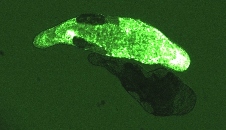Intralocus sexual conflict in hermaphrodites

GFP-marked (upper) and unmarked (lower) worms. Photo courtesy of Micha Eichmann.
In this project, we are investigating what happens when a hermaphrodite experiences sex-limited selection on a synthetic sex chromosome. The study species is Macrostomum lignano, a free-living, obligate outcrossing, hermaphroditic flatworm. This species has had the gene for green fluorescent protein (GFP) introgressed into its genome. By using the GFP locus as a marker, it can essentially become a sex-determining gene. This will result in the build up of a genetic correlation between the GFP colour marker and sex-specific fitness loci. The experimental design is inspired by previous studies carried out in insects, where experimental evolution has been used to build-up a genetic correlation between a colour marker locus and a trait of interest. There are three experimental treatments, each with several replicate populations: one "male" treatment, where marked worms only pass on their genetic material through sperm, one "female" treatment, where marked worms only pass on their genetic material through eggs, and one control. In the "male" and "female" treatments this should create very strong selection to invest in the appropriate sex function, and sex-specific loci with any sort of genetic linkage to the GFP locus (physical, epistatic, or pleiotropic) will be favoured. This means that in the "male" treatment all GFP-linked standing genetic variation for increased fitness via sperm will accumulate while loci for increased fitness via eggs will be filtered out (and vice versa for the "female" treatment).
We have been able to confirm a response to the sex-specific selection protocol after 15 generations, and are currently engaged in investigating the genomic basis of the response. This experiment is also supplemented with a quantitative genetic analysis of standing sexually antagonistic genetic variation for fitness in M. lignano, as well as analytical and simulation modeling of the maintenance of sexually antagonistic genetic variation in hermaphroditic species in general.
Students: Anna Nordén
Collaborators: Lukas Schärer, University of Basel (empirical aspects), and Sam Tazzyman, ETH Zürich (modeling)
